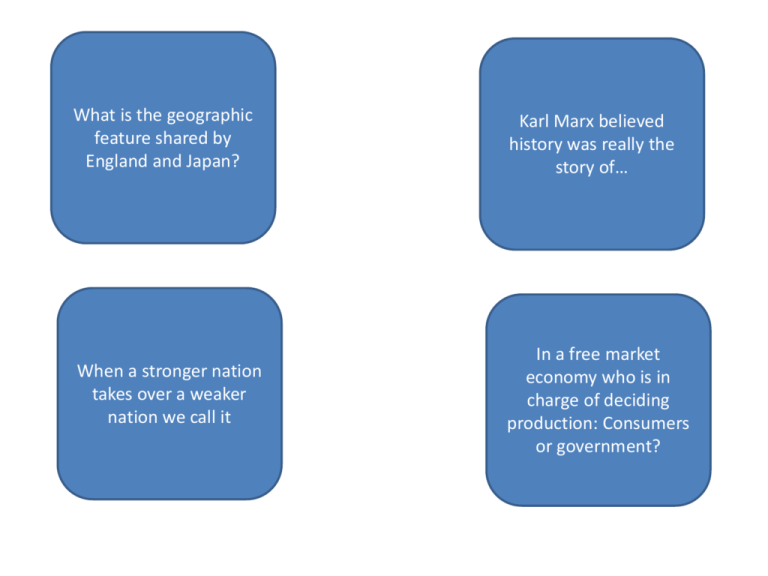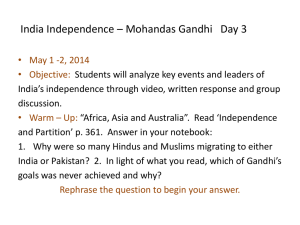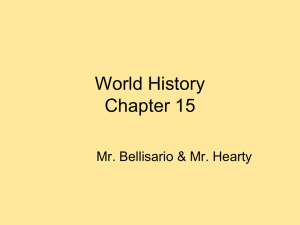Turkey, Iran and Gandhi
advertisement

Islands What is the geographic feature shared by England and Japan? The struggle Karl Marx between thebelieved history wasand really the proletariat story of… the bourgeoisie Imperialism When a stronger nation takes over a weaker nation we call it consumers In a free market economy who is in charge of deciding production: Consumers or government? Bell Ringer M- Militarism A-What Alliance are the I- Imperialism causes of WWI? N-Nationalism Disobeying unjust laws What is Civil Disobedience? Textile Spinning Jenny Transport systems Name 3 Technologies (railroads, Steam Ships, that came out of the Turnpikes) Industrial Revolution Factory machines Communication systems Mustafa Kemal Who modernized Ata-Turk: of was the Turkey?Father What Turks his nick-name Nationalism around the World 1914-1939 After WWI many countries began campaigning for independence Ottoman Mandates Many of the Arabs of the Middle east worked with the Allies against the Central Powers during WWI. They were promised independence after the war. After WWI the allies partitioned the old Ottoman Empire into mandates, or territories. The mandates included: Palestine Jordan Mesopotamia Syria Turkey Turkey was occupied by French, British, and Italian and other Western powers. MandateTerritories given to European nations after WWI Turkey and Atatϋrk 1923-1938: Mustafa Kemal led Turkish nationals to defeat western occupation Took the name Atatϋrk, or father of the Turks. Primary Goal: Rid Turkey of foreign influence and occupation. Then protect it from imperial forces. Battle for independence Atatϋrk and his forces spent two years battling the forces of France, Britain, Armenia, Italy and Greece. In September 1922 the last of the occupying forces was finally expelled. Turkey is at the crossroads of Europe and Asia, making a valuable location for trade, and sought after by imperial powers. What do you think Mustafa should do with his newly independent nation? Hint: Think about Japan, Thailand and Ethiopia Industrialize and Modernize Modernizing Turkey Ataturk did a lot to industrialize and modernize Turkey from a traditional Islamic nation to a Modern Western nation. Before After Islamic law Law code based on European models Muslim Calendar Western Calendar (Gregorian/ Christian) Robes, women veiled Western clothing- veils outlawed Arabic Script ()األبجدية Western Latin based (Alphabet) Polygamy Monogamous marriage only Religious led government (Muslim) Secular government separate from religion Mixed feelings Many Turks look at Mustafa Atatϋrk as a hero who freed Turkey from foreign influence and established a strong Turkish nation. Others condemn Atatϋrk for because he replaced the Quran led government with secular authority. SecularEarthly or worldlyNOT religious Iran Iran was independent, but was occupied by two spheres of Influence: -British South -Soviet North In 1925 Reza Khan, a military soldier, overthrew the Shah (ruler) and seized power Like the Turks, Khan begins a push to modernize Iran to become independent. Modern Iran Under Reza Khan, Iran built factories and improved infrastructure (roads, bridges, communication systems) Iranians adopted Western clothing, written language and culture. Khan also introduced European based law codes. Not all supported Khan, who may disagree with his actions? Strict Islamic followers Oil Agreements As Iran modernized they forced the British oil companies to give more profit to Iranians, and hire qualified Iranians in all oil production jobs. Over the rest of the 1900s Iran’s oil fields will become a source of contention between the Iranians and the Western powers. Broken Promises During WWI the allies made 2 promises to gain support during WWI: 1) The Arabs would have their own kingdoms in the former Ottoman Empire (including Palestine) 2) Britain issued the Balfour Declaration to win support of European Jews. The document promised support for a “national home for the Jewish people” in Palestine. What is the problem with these promises? They promise Palestine to two separate groups, the Arab Muslims and the Jewish people Balfour Declaration In order to gain the support of Europe’s Jews during WWI, the British had promised to give the Jewish people a national home to satisfy Zionism. After WWII and the Holocaust the British make good on their promise to the Jews, but not to the Palestinians. Conflict reigns As growing anti-Semitism spreads across Europe, many Jews are forced to seek safety in Palestine. At first they are welcomed because they bring money and technology with them. The Jewish immigrants built factories and irrigated the desert to grow crops. Soon industrial cities developed with large Jewish population. Over time, however, the Jews began to purchase land then evict the Arab tenants. Many Jewish factory owners refused to hire Arab workers. Conflict brewed between the Muslims Arabs and the Jewish immigrants According to this political cartoon, who does the US side with? Conflict remains today The most recent occurred in November 2012 between the Gaza Strip and Israel India India is where Hinduism and Buddhism developed. Hinduism was the dominate religion and society was ruled by the Caste System The British took India over during the Imperialism age, and forced Indians to grow cash crops and turn against their traditional values. Resentment During WWI many British subjects, including the Indians, were sent to the front lines to fight for Britain and the Allies. Millions died, but the subjects believed their work in the war would be rewarded with freedom and equality. Instead, the British continued to exploit their colonists. By 1918 protests were common in India. In response, the British ban public gatherings of natives. Amritsar Massacre April 13, 1919- thousands of Indians gather in a walled field in Amritsar for a peaceful protest. They were protesting British control and unfair treatment. General Reginald Dryer ordered his troops to fire into the crowd. The crowd was trapped by the walls and for 10 minutes the firing continued. 379 perished, and over 1100 were wounded: men, women and children “My intention was to inflict a lesson, that would have an impact throughout India” General Dyer Considering it was war time, and the British needed Indian support, was it ok or not ok for the General to act as he did? Mohandas Gandhi Gandhi was a leader among the Indians for independence. -at 19 he studied law in England -worked in South Africa to help Indian emigrants -in Africa Gandhi developed the idea of nonviolent (passive) resistance or “soulforce” -when he returned to India, Gandhi led by example Gandhi rejected western ideals, including their clothing Civil Disobedience Gandhi believed in civil disobedience; the refusal to obey unjust laws. He launched non-violent actions like boycotting British goods, especially textiles. Women took up sewing and created clothes for their families One of Gandhi’s biggest successes was the Salt March The Salt March- 1930 Britain claimed exclusive rights to produce salt. However, salt was free from the sea and it was illegal to use it. Gandhi told the British he would break the law and get salt from the sea. He started his march with 78 followers. By end of the 240 mile trek he had thousands. Arrested Gandhi and hundreds more were arrested as they continued to get salt from the sea. Hundreds more were beaten as they attempted to get salt… none of the beaten raised a hand in defense. What do you think the British had to lose from the Salt march? Why is the Salt march so important as a symbol of Indian nationalism? India and Pakistan Partitioning- Split up or separate Outcome of Gandhi India became an India for Hindus Pakistan is created for Muslims The splitting of India is know as Partitioning- or separatingof India. China “In comparison with other nations, we have the greatest population and the oldest culture, of 4,000 years’ duration. We are the poorest and weakest state in the world. While other countries were the carving knife and the serving dish we are the fish and the meat.” -Sun Yixian What countries might be the knife? China Sun Yixian had led a revolt ending the Qing Dynasty. He envisioned a democratic China, and asked for help from foreign powers. Only the Soviet Union would help. Sun led the Goumindang (nationalist) party Why would the western powers not help? Jiang Jeishi Jiang took over when Sun passed away in 1925. He was supported by the rich business leaders. Began a campaign to unite China under his control. Viewed communism as a threat- he ordered thousands of communists killed Mao Zedong A communist who escaped Jiang’s brutal attacks. He sought to spread communism through the proletariat AND large peasant masses. How does Mao’s plan to spread communism differ from Karl Marx’s beliefs? The Long March 1934-1935 Jiang was determined to oust the communists (red bandits) He began a campaign to exterminate them. Using troops he repeatedly attacked the communists To survive, the communists led by Mao retreated throughout China, over 6,000 miles! Of the 100,000 communists who start the march, only 20,000 survive. Nearly 6,000 miles long Gaining popularity Though Mao and his men are fleeing for their lives, the Long March becomes an excellent opportunity to gain more support. Mao instructs his men to “not take a single needle or a piece of thread from the people” The communists had to pay for goods, avoid damaging crops, and be polite to local peasants. In contrast, Jiang’s troops created damage and often plundered. If you were a peasant, who would you support? Why? Mao or Jiang? Japan Invades While Jiang is pursuing the Communists, Japan takes advantage and invades Northeast China (through Manchuria). China is pulled by three forces: -Communists -Jiang and the Goumindang -Japan Jiang has to work with the Communists to get rid of Japan How did Iran and Turkey get rid of foreign occupation? They modernized and educated their populations, then forced better trade terms and independence. What does Gandhi mean by soulforce? Civil disobedience? Nonviolent or passive resistance. By using nonviolence and civil disobedience the Indians would win independence. Civil Disobedience is refusal to follow unjust laws (Salt Production) How does Mao Zedong envision communism growing in china? Mao thinks the proletariat AND the peasant masses must work together to bring communism to China.



